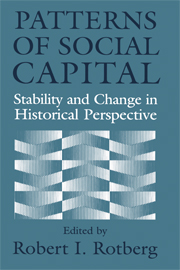Book contents
- Frontmatter
- Contents
- Introduction Social Capital and Political Culture in Africa, America, Australasia, and Europe
- Articles
- Civic Traditions in Premodern Italy
- The Sources of Civil Society in Italy
- Finding Social Capital: The French Revolution in Italy
- Social Capital in the Early Industrial Revolution
- The Diversity of Social Capital in English Communities, 1300–1640 (with a Glance at Modern Nigeria)
- Social and Cultural Capital in Colonial British America: A Case Study
- The Growth of Voluntary Associations in America, 1840–1940
- Civil Society as Democratic Practice: North American Cities during the Nineteenth Century
- Securing Political Returns to Social Capital: Women's Associations in the United States, 1880s–1920s
- Second-Generation Civic America: Education, Citizenship, and the Children of Immigrants
- Human Capital and Social Capital: The Rise of Secondary Schooling in America, 1910–1940
- From Local to National Political Cultures: Social Capital and Civic Organization in the Great Plains
Finding Social Capital: The French Revolution in Italy
Published online by Cambridge University Press: 12 April 2010
- Frontmatter
- Contents
- Introduction Social Capital and Political Culture in Africa, America, Australasia, and Europe
- Articles
- Civic Traditions in Premodern Italy
- The Sources of Civil Society in Italy
- Finding Social Capital: The French Revolution in Italy
- Social Capital in the Early Industrial Revolution
- The Diversity of Social Capital in English Communities, 1300–1640 (with a Glance at Modern Nigeria)
- Social and Cultural Capital in Colonial British America: A Case Study
- The Growth of Voluntary Associations in America, 1840–1940
- Civil Society as Democratic Practice: North American Cities during the Nineteenth Century
- Securing Political Returns to Social Capital: Women's Associations in the United States, 1880s–1920s
- Second-Generation Civic America: Education, Citizenship, and the Children of Immigrants
- Human Capital and Social Capital: The Rise of Secondary Schooling in America, 1910–1940
- From Local to National Political Cultures: Social Capital and Civic Organization in the Great Plains
Summary
[History] should be explored, not for scenes of carnage, but for instruction in the government of mankind.
J. C. L. Sismondi de Sismondi, A History of the Italian RepublicsIf social capital were sharply defined, the term would be less usefully suggestive. It seems to refer to those social practices, customs, groups, and institutions that strengthen civil society. In a sense, the concept is always retrospective. We acknowledge the presence of “social capital” whenever we attribute collective (essentially political) behavior more to established patterns of social behavior than to immediate requirements, interests, or tactical calculations. The term is temptingly residual, a signifier for social behaviors not simply selfish, and it tends to be used in notably judgmental ways, treating as social capital those practices considered beneficial to society's smooth functioning. Logically, this usage seems somewhat circular and historically rather deterministic.
I propose to make this loose term looser, by expanding it to include cultural capital. By cultural capital, I mean the customs of public behavior (a part of culture in the anthropological sense) and the content of shared values (as communicated through the literature and arts of high culture). This definition extends the idea of social capital as used by Putnam and his associates. They measured social capital primarily in terms of voluntary organizations, on the grounds that associational life may, as Tocqueville thought it did, build habits of cooperation and trust that facilitate effective, democratic government. Thinking in the broader terms of cultural capital invites attention to less institutionalized habits of association that may also be important, especially when governments restrict organized activity.
- Type
- Chapter
- Information
- Patterns of Social CapitalStability and Change in Historical Perspective, pp. 69 - 96Publisher: Cambridge University PressPrint publication year: 2000
- 1
- Cited by



